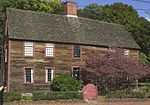Belle Isle Marsh Reservation
1985 establishments in MassachusettsAC with 0 elementsEast BostonParks in BostonProtected areas established in 1985 ... and 1 more
State parks of Massachusetts

Belle Isle Marsh Reservation in Suffolk County, Massachusetts is an urban nature preserve and public recreation area containing mostly coastal wetlands. The Reservation includes the last remnant within Boston of the salt marshes that were once prevalent along the Massachusetts Bay shoreline. The marsh is home to a wide variety of saltmarsh plants, marine life, and birds. The reservation is managed by the Department of Conservation and Recreation.
Excerpt from the Wikipedia article Belle Isle Marsh Reservation (License: CC BY-SA 3.0, Authors, Images).Belle Isle Marsh Reservation
Summer Street, Revere
Geographical coordinates (GPS) Address Nearby Places Show on map
Geographical coordinates (GPS)
| Latitude | Longitude |
|---|---|
| N 42.389166666667 ° | E -70.989166666667 ° |
Address
Belle Isle Marsh Reservation
Summer Street
02152 Revere
Massachusetts, United States
Open on Google Maps










